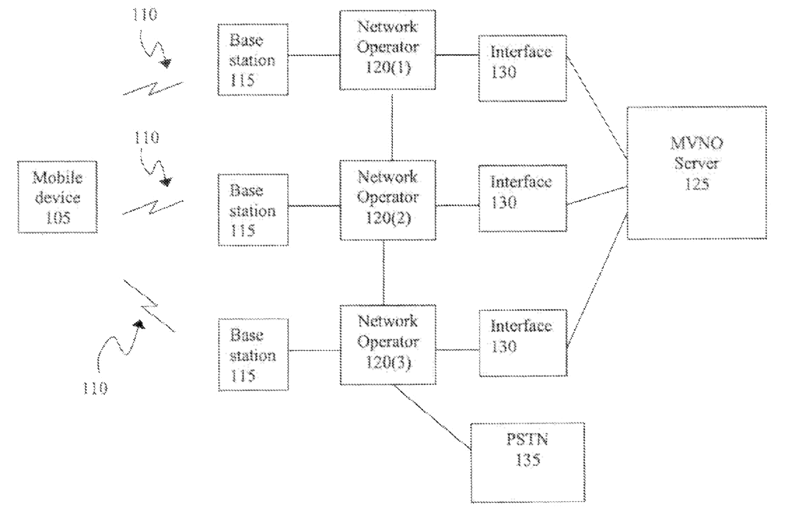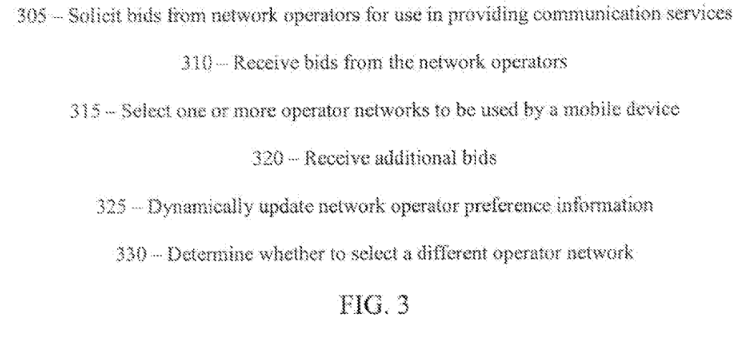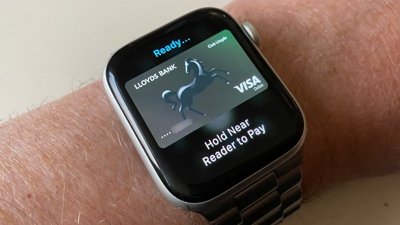In the years and months leading up to the release of its iPhone handset, Apple Inc. considered forming its own mobile virtual network operator (MVNO) system which would interface with multiple primary wireless carriers to always provide users with the lowest possible rates depending on their location, a company filing has revealed.
Unlike traditional MVNOs that serve up wireless minutes purchased in bulk from one established carrier (such as AT&T) at a fixed cost to the user, Apple's backup plan called for a system that would allow all primary wireless carriers within a specific region to serve iPhone users by bidding prices for their service in a dynamic, real-time model.
Under the proposed model, each iPhone with a stored network address would be in constant communication with an iTunes-like mobile virtual network operator server, feeding the server real-time information about its geographic location. In return, the server would query its database of participating wireless networks within that region, and then select a carrier for the iPhone based upon predetermined rates from those carriers for that region.
Alternatively, Apple's MVNO could also insert the user in the network selection process by allowing them to select their own carrier based upon the best available rates for the particular region at a particular time of the day or week.
"Bids can be received from multiple network operators for rates at which communication services using each network operator can be obtained. Preferences among the network operators can be determined using the received bids, and the preferences are used to select the network operator," Apple's iPod chief Anthony Fadell wrote in the filing.
"Preferences may be further based on a location of the mobile device, the quality of service offered by the network operator, and/or type of communication. Bids from multiple network operators for rate information relating to rates at which communication services using each network operator can be obtained and the rate information can be sent to the mobile device for use in selecting the network operator."
Fadell added that rate information would be displayed on a user interface of the iPhone so that user selection of the network operator can be performed by the user. The iPhone would be registered with a network operator for a limited purpose of sending the request and receiving the network operator data in response to the request, and would separately be registered with the selected network operator for conducting communications after receiving the network operator data.
"The network operator preference data can be updated to identify a second set of preferences among the multiple network operators, and the updated network operator preference data can be sent to the mobile device," Fadell wrote.
"In addition, updating the network operator preference data can be performed dynamically based on parameters associated with the multiple network operators. The parameters include bids relating to rates at which communication services are available from each network operator, data relating to the network operators in an area corresponding to the current location of the mobile device, and/or rate information for different communication services available from each network operator."
As such, the updated network operator preference data would enable an iPhone to automatically select among multiple network operators as the user alters his or her location, always providing that users with the strongest possible signal and lowest possible rates.
Under such a model, Apple would presumably handle the accounting end, tabulating the users monthly bill and handling payments between the various participating carriers on its network.
 AppleInsider Staff
AppleInsider Staff















 Sponsored Content
Sponsored Content
 Wesley Hilliard
Wesley Hilliard

 Andrew Orr
Andrew Orr
 Amber Neely
Amber Neely

 William Gallagher
William Gallagher









46 Comments
I had assumed that an MVNO was a consideration, it looks like maybe it really was. From a cost standpoint, I'm not sure if dynamic, real time prices would necessarily make sense though. If you're selling service contracts, you want to have your expenses locked down so you don't have surprises.
An interesting concept. How would this translate to various market around the world, and for that matter international roaming. What I am really asking, is this doable outside of the USA.
I really like that idea.
Somehow seems so simple and obvious by hindsight. Makes you wonder, how come no one else thought of it before?
Of course, it raises the larger question of why Apple itself would not want to implement similar 'dynamic pricing' for say, iTunes downloads?
If Apple was considering this, why did they end up tying the service to AT&T? I think it would have been much better to implement this technology than have to pay through a certain carrier even if it meant higher costs for the Phone itself. I sure hope they implement this in the new iPhone because there are better services out there than AT&T.